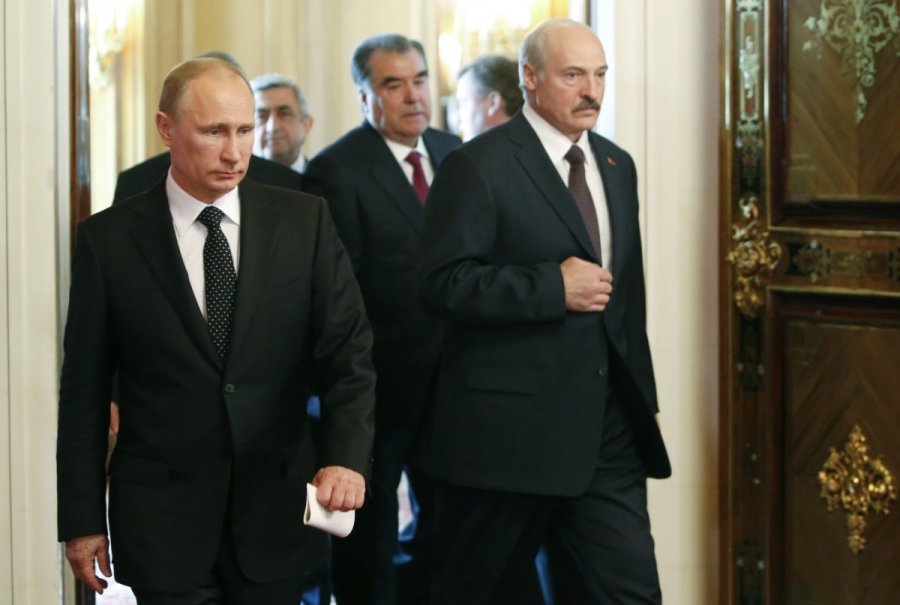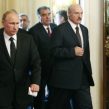
Belarusian Foreign, Economic Policies Increasingly Diverge From Russia’s
Publication: Eurasia Daily Monitor Volume: 13 Issue: 5
By:

Russia and Belarus have some of the closest relations in the post-Soviet space. Both are members of the Commonwealth of Independent States (CIS), the Collective Security Treaty Organization (CSTO), and the Eurasian Economic Union (EEU). And together, the two countries make up the Union State. Their political and economic interests are not identical however, and divergences have appeared since Russia’s March 2014 annexation of Crimea. Belarus famously declined to participate in Russia’s counter-sanctions, developed in response to those imposed by the United States and the European Union over Russia’s Ukrainian policy; and more recently, Minsk has lent only tepid diplomatic support to Russia’s Syrian policy (see EDM, January 5, 2016).
Belarusian-Russian economic relations, traditionally close, have deepened with the inauguration of the EEU, which marked the first anniversary of its operation on January 1, 2016. The EEU was created on the foundation of the Customs Union and the Common Free Market Zone of Russia, Belarus and Kazakhstan. The EEU, which last year added Armenia and Kyrgyzstan, has not brought the hoped-for economic benefits to member states. Speaking on the anniversary, Eurasian Economic Commission Collegium Chairman Viktor Khristenko stated that the EEU’s trade turnover with third countries dropped by 34 percent in 2015, while volume of bilateral trade inside the EEU had in fact not increased, but declined 25 percent (TASS, January 1, 2016). Last year Belarus, as the chair of the EEU, introduced a draft resolution at the United Nations to grant the EEU observer status.
As recession continues to drag down the post-Soviet economies, Belarus is developing economic options beyond Russia, despite their common interests, by drawing closer to the EU. For one thing, it remains an important transit country for Russian gas sales to Europe. Furthermore, the European Union is now Belarus’ second main trade partner, with almost a one-third share in the country’s overall trade: EU-Belarus bilateral trade has been growing steadily over the past several years to more than $5 billion in 2014 (Ec.europa.eu, accessed January 7, 2016). This development is at odds with Russia’s relations with the EU, which are now entangled in a thicket of sanctions and counter-sanctions.
Papering over these differences, last year ended with Belarusian President Alyaksandr Lukashenka visiting Vladimir Putin in Moscow, where the two presidents put on a show of unity (see EDM, January 5, 2016). Following their discussions, President Putin told journalists, “We noted the closeness of our countries’ positions on such urgent issues as the settlement of the Ukraine crisis and the fight against international terrorism in Syria. Russia and Belarus pursue a coordinated foreign policy in the international arena” (TASS, December 15, 2015). Putin emphasized, “For the purpose of strengthening regional stability and security, we agreed to actively develop military-technological cooperation.”
But Belarus is not limiting its “military-technological cooperation” to Russia. On December 7, Ukrainian Minister of the Interior Arsen Avakov proudly displayed the new Ukrainian Varta 4 x 4 armored personnel carrier (APC), which, he told journalists, was designed in cooperation with “Belarusian engineers” (5 Kanal, December 7, 2015). The APC is certain to show up in Ukraine’s eastern region of Donbas, as Avakov added, “Today the guys from the Kulchytsky battalion, Azov, Donbas and other NGU [National Guard of Ukraine] units, after the ceremony of awarding state decorations in the MIA [Ministry of Interior], came out together and gathered around the new [Varta] armored vehicle. They praised it, asked about it and tried to take it away with them. They are so glad that soon their units will receive such beauties! Before the New Year, we shall get the first ten armored vehicles” (Ministry of Internal Affairs of Ukraine, December 9, 2015).
If nothing else, geography binds Belarus and Russia to similar fates, whatever policy disputes emerge. On October 27, in Moscow, Belarusian Foreign Minister Vladimir Makei and Russian Foreign Minister Sergei Lavrov signed a mutual foreign policy action plan for 2016–2017. Makei said, “It is a profound, multi-purpose and systemic document that covers all spheres of cooperation. It is a document of direct action for our ministries. The common goal for Belarus and Russia on the international arena is a search for solutions to global and regional issues” (Naviny Belarusi, Belaruskae Telegrafnae Agentstva, October 27, 2015).
Again, however, as in its military cooperation, Belarus is not guided solely by Moscow’s dictates. On November 24, Turkey downed a Russian Su-24 aircraft that allegedly violated Turkish airspace, a violation that Russia vociferously denied. But rather than unquestioningly support Moscow, Minsk instead offered its diplomatic offices to resolve the political tensions between Russia and Turkey. On January 4, Foreign Minister Makei told the Belarus 1 TV channel that his country would mediate between the pair if asked, commenting, “Belarus is not going to impose mediation services on anyone. We are judging by the fact that the pressure on each other and sanctions are not the means for the resolution of issues in interstate relations. As for the recent disagreements between Russia and Turkey, I am convinced that sooner or later this conflict will be resolved. We are interested in regulating this conflict as soon as possible and are ready, if necessary, to do our utmost for it” (Naviny Belarusi, Belaruskae Telegrafnae Agentstva, January 4, 2016). In a further diplomatic offer unlikely to be appreciated in Russia, Makei added, “We cannot make the sides act in a way we would like them to act, but we can voice our opinion. We are doing the same for Ukraine.”
Belarus’s geographical position is a metaphor for its political and economic policies—that is, situated between East and West, despite both Europe and Russia frequently perceiving it as a mere appendage, slavishly subservient to Moscow’s dictates. A buffer state between the North Atlantic Treaty Organization (NATO) and Russia, a transit country for Russian gas sales to Europe, Belarus is too useful to Russia for it not to overlook certain policy divergences, however irritating Putin’s administration may find them. Belarusian offers of mediation in Russia’s political disputes and Belarusian interest in economic relations beyond the EEU are glimmers of Belarusian policy initiatives. These should be viewed in an indigenous nationalist context, which, for the Russian government, would be far preferable to yet another “color revolution” in Europe’s East.




